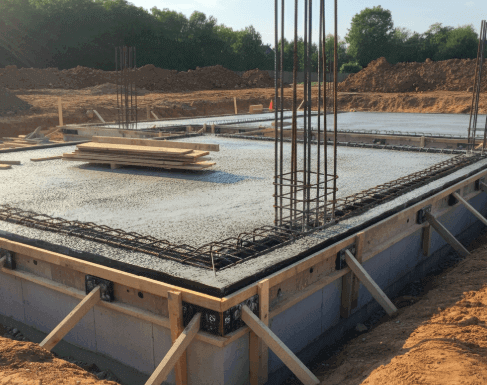What is a foundation in construction? It’s the base that supports your entire building, and getting it right can save you time, money, and headaches. Industry data shows that foundations and site work can account for 10–15% of total construction costs, and moisture-related foundation issues contribute to billions of dollars in repairs nationwide each year. The right type—slab-on-grade, crawl space, basement, or deep foundations such as piers and piles—depends on soil conditions, climate, and load requirements. Choosing wisely improves energy efficiency, reduces cracks and settlement, and protects your investment over decades. What is a foundation in construction? It’s also your first defense against water intrusion and shifting soils, which is why proper drainage, compaction, and waterproofing matter. Get practical guidance on your property’s costs, timelines, and best approach. Connect with Steve Daria and Joleigh, renowned real estate investors and cash land buyers. They’ve evaluated hundreds of sites and understand what truly works. Book a free discussion today to get straightforward advice and options tailored to your project.
What is the main purpose of a foundation in construction?
The primary purpose of a foundation is to safely transfer the entire weight of a building to the ground below.
It serves as the critical base that keeps the structure stable, level, and secure against forces such as wind, water, and even earthquakes.
A strong foundation keeps your building from settling unevenly, preventing cracks in walls and floors.
It also helps manage moisture and insulate your home.
Common types like slabs, crawl spaces, basements, and deep piers all achieve this goal, with the best choice depending on your soil and climate.

So, what is a foundation in construction? It is the essential element that anchors the structure, distributing its load to prevent movement and damage over time.
Proper site preparation, including good drainage and waterproofing, is crucial for its success.
A solid foundation is your first line of defense, significantly lowering the risk of costly future repairs.
Ultimately, it protects the long-term value and safety of your entire investment.
Get Started: Get Your Cash Offer Below…
We are direct land buyers. There are no commissions or fees and no obligation whatsoever. Start below by sharing where your property is and where we can send your offer…
What is the difference between a shallow and a deep foundation?
The main difference between a shallow and a deep foundation is how far down they transfer a building’s weight into the earth.
Shallow foundations, like slabs, crawl spaces, and strip footings, sit close to the surface and are used when the topsoil is strong enough to support the structure.
They work by spreading the building’s load over a wide area, making them a common and cost-effective choice for homes and garages.
In contrast, deep foundations like piers and piles are necessary when surface soil is weak, reaching far underground to transfer loads to stronger soil or bedrock.
This answers the question, “What is a foundation in construction?” by showing it is a solution tailored to site-specific challenges.
These systems are used for heavy buildings, coastal properties, or sites with poor soil, but they require more complex equipment and a bigger budget.
A shallow foundation might be just a few feet deep, while a deep one can extend over a hundred feet.
A geotechnical report from a soil engineer is essential to figure out the safest and most cost-effective option for your project.
What factors affect the cost of building a foundation?
- Foundation Type and Size: The type you choose is the biggest cost driver, with a slab costing $8–$20 per square foot versus $30–$70 for a full basement. A larger, deeper foundation requires more materials and labor, making a basement significantly more expensive than a simple slab-on-grade design.
- Soil Conditions and Site Prep: Poor soil quality, such as loose sand or expansive clay, may require costly engineering and reinforcement to ensure stability and safety. Additionally, extensive site work, such as clearing trees, significant grading, or hauling away dirt, will increase your total project budget.
- Materials, Labor, and Access: The fluctuating prices of concrete and steel reinforcement directly impact your costs, as do local labor rates, which can vary widely by region. A construction site with difficult or limited access for heavy equipment can also lead to higher labor charges and longer timelines.
- Design Complexity and Engineering: Understanding “What is a foundation in construction?” involves recognizing that complex home designs with multiple corners or steps require more intricate, costly formwork. Any custom engineering needed to address unique site challenges, such as deep piers, will also add thousands to the cost.
- Permits, Inspections, and Finishes: Your budget must account for building permits, mandatory city inspections, and essential extras such as waterproofing and drainage systems. These features are critical for preventing future moisture problems and ensuring your foundation complies with local building codes and standards.

How do I know which type of foundation is best for my building project?
Choosing the best foundation for your project requires evaluating several key factors, starting with your property’s soil.
A professional geotechnical report will reveal your soil’s strength and water content, which is the most important step.
Climate also plays a huge role; you must consider the local frost line depth, rainfall, and any flood risks.
The building’s size, weight, and layout will further narrow your options, as will your overall budget and timeline.
When people ask, “What is a foundation in construction?” the answer is a system perfectly matched to these conditions.
Slabs are cost-effective for simple structures, crawl spaces offer utility access, and basements provide extra living space, especially in cold climates.
For weak or wet soils, deep piers or piles may be necessary to ensure stability.
Consulting a structural engineer and your local building department is the final step to select a safe, code-compliant, and cost-effective design for your specific needs.
How long does it take to build a foundation for a home?
- Permitting and Scheduling: Before you start digging, you’ll need to get building permits, which can take several weeks depending on your local council. This is also when your contractor will schedule the excavation crew, concrete delivery, and any required inspections.
- Site Prep and Excavation: This stage involves clearing the land, grading the site, and excavating the foundation area, which typically takes a few days to a week. The timeline can be longer if the site has many trees or large rocks, or if extensive soil removal is required.
- Forms, Reinforcement, and Inspections: Crews build wooden forms to shape the concrete and install steel rebar for strength, which usually takes several days. A city inspector must then approve this work before any concrete can be poured, ensuring it meets all safety codes.
- Concrete Pour and Curing: Pouring a typical home foundation usually takes one day. The concrete then cures, gaining enough strength to support weight in about a week, but continues hardening for months.
- Finishing Touches and Final Cure: Understanding “What is a foundation in construction?” means recognizing that it includes final steps such as backfilling, installing utilities, and applying waterproofing. This final phase can take another one to two weeks, after which the foundation is ready for framing to begin.
How can I maintain and protect my building’s foundation over time?
Protecting your home starts with taking care of your foundation, and that means managing water effectively.
Clean your gutters. Downspouts need to be 5 to 10 feet away from the walls, and the ground should slope down.
Try to keep soil moisture levels consistent around your home, avoiding both overwatering near the foundation and letting the soil dry out and shrink.
Be mindful of landscaping; keep large trees and shrubs with invasive roots away from the foundation or install root barriers.
If you understand the answer to “What is a foundation in construction?” you know it’s a system that plumbing leaks can damage, so fix them immediately.
Regularly inspect for new cracks, sticking doors, or uneven floors, especially as seasons change.
Sealing small concrete cracks and performing routine pest control can also prevent long-term damage.
For personalized guidance on protecting your specific property, book a free discussion to explore your best options.
Takeaways
- Understand the Foundation’s Core Purpose: A foundation’s primary role is to safely transfer the entire weight of the building to the ground, providing stability and preventing uneven settlement. It anchors the structure against movement from soil, water, and wind, which protects your long-term investment.
- Recognize the Different Foundation Types: Answering “What is a foundation in construction?” involves knowing the main types: slabs, crawl spaces, and basements are common shallow options. Deep foundations like piers are used for weak soil, while the best choice always depends on your specific site conditions and goals.
- Identify Key Factors Driving Costs: Foundation costs are primarily driven by the type and size you choose, with basements being the most expensive and slabs the least. Other major expenses include site preparation for poor soil, local material and labor prices, and necessary permits and inspections.
- Plan for a Multi-Stage Timeline: Building a foundation takes several weeks and involves distinct phases, from permitting and excavation to concrete pouring and curing. Each stage requires inspections to ensure safety and code compliance, and weather and complexity can affect the schedule.
- Prioritize Maintenance to Protect Your Home: Protect your foundation by managing water with proper drainage, keeping gutters clean, and correcting soil grading to prevent moisture damage. Regular inspections for cracks or shifts, along with careful landscaping, are simple steps to avoid costly future repairs.
**NOTICE: Please note that the content presented in this post is intended solely for informational and educational purposes. It should not be construed as legal or financial advice or relied upon as a replacement for consultation with a qualified attorney or CPA. For specific guidance on legal or financial matters, readers are encouraged to seek professional assistance from an attorney, CPA, or other appropriate professional regarding the subject matter.
